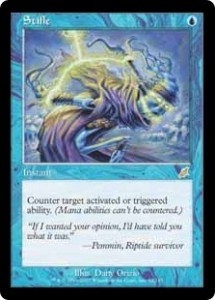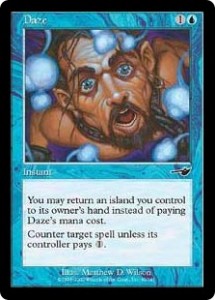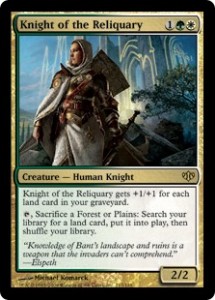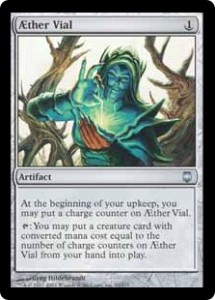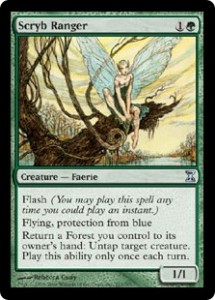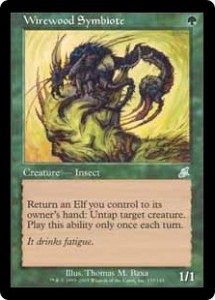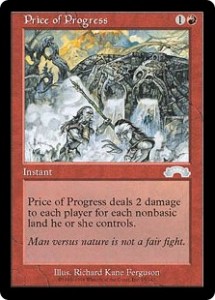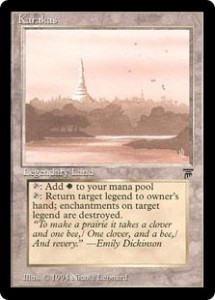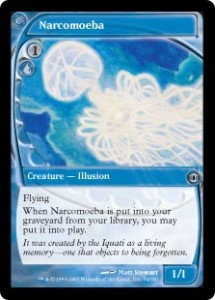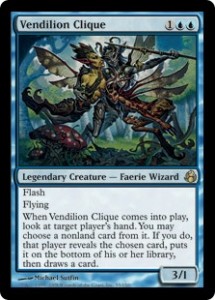“In response, I’ll…”
Sure, such a response is expected when you try to cast a big spell or make an alpha strike in any format, but because Legacy is such a vast format, there are plenty of tricky interactions and abilities that can potentially blow an unsuspecting opponent out of the game. If you are new to Legacy, prepare to get Stifled, Wastelanded, or Cliqued out of the game. However, while you may not be able to stop these cards, you can at least prepare for it. Here is a list of ten common Legacy cards that if not accounted for, can cost you games.
Stifle
Most commonly seen in: RUG Delver and other tempo decks
What it does: Stifle’s rules text is only one sentence long but it does oh-so much. At first glance, Stifle has obvious applications—Stoneforge Mystic trigger or activated ability, Grim Lavamancer ability, or a Jace ability are common Stifle targets, but the primary use of Stifle is stopping fetchlands such as Flooded Strand. With the number of fetchlands in any given deck is anywhere from four to twelve, Stifle may as well read “Destroy target land. Its controller loses one life.” Stifle decks take advantage of this temporary tempo loss by using quick creatures like Delver of Secrets and Nimble Mongoose to finish off their opponents while they are scrambling to stabilize their mana base.
How to play around it: There are various ways to play around Stifle with fetchlands. In the early turns, try fetching in response to fetchland activations if the only land they have is a fetchland. Of course, there is fetching when they’re tapped out.
However, another way to fight Stifle is to actually play into Stifle. If they’re holding a Stifle and you’re busy playing around it with fetchlands, they’ll have the Stifle for when you really need it, like activating Jace or a Pernicious Deed. Activate your fetchlands during their upkeep, so they are forced into two choices:
- Tap a valuable mana source in order to stop your mana development. This will very likely delay them a turn since tempo decks are often mana-tight. This extra turn gives you another turn to make another land drop, making the Stifle near useless.
- Let the fetchland go so they can tap out and play other spells, so their Stifle begins to lose value.
Another gem is Wastelanding them during their upkeep, which also gives them two choices:
- Tap a mana source to save that mana source
- Lose a land
Both essentially buy you a turn, so it’s a win-win.
Daze
Most commonly seen in: RUG Delver, Merfolk, and other tempo decks
What it does: Daze is a very powerful card seen in tempo decks. It allows tempo decks to continue to apply pressure without having to leave mana open for counterspells. This makes it tricky for people to interact and stay on curve because they risk getting blown out by Daze.
How to play around it: Playing around Daze is all about evaluating the risk. If your opponent has Volcanic Island into Delver of Secrets, is it worth Lightning Bolting it on your turn one? Sometimes it’s worth taking a hit or two in order to not get hit by Daze. How much tempo are you going to lose if your opponent Dazes you? Just remember that it’s less than a 50% chance that your opponent will have Daze in their opening hand anyway.
Knight of the Reliquary
Most commonly seen in: Maverick, Bant, Junk
What it does: Knight of the Reliquary encourages a toolbox of utility lands. When it’s not attacking, it’s getting bigger and providing its owner plenty of value. A land toolbox may have lands such as:
- 2-4 Wasteland
- 1-4 Horizon Canopy
- 2-4 Cavern of Souls
- 1 Dryad Arbor (usually in conjuction with Green Sun’s Zenith)
- 1 Maze of Ith
- 1 Karakas
- 1 Gaea’s Cradle
- 1 Bojuka Bog (from the sideboard)
- 1 Stirring Wildwood
- 1 Tower of the Magistrate
How to play around it: When your opponent untaps with a Knight of the Reliquary, be aware of how these different lands can affect your situation. How will a Wasteland affect your next turn play? What about Maze of Ith? If you have equipment on the field, how will you deal with a Tower of the Magistrate? If you can anticipate the Knight’s lines of play, you’ll be much better prepared to deal with the Knight from Bant.
AEther Vial
Most commonly seen in: Merfolk, Goblins, Death and Taxes
What it does: AEther Vial’s tricks don’t come from cheating creatures into play for free; it comes from the fact that it can be instant speed. While Goblins doesn’t have many tricks up its sleeve (it mainly uses AEther Vial to cheat creatures into play while denying their opponent’s resources with Wasteland and Rishadan Port), Merfolk and Death and Taxes have interesting interactions with AEther Vial.
How to play around it: Just like Knight of the Reliquary, fighting AEther Vial is simply anticipating particular lines of play. Merfolk’s tricks with Vial include putting in Lord effects after blockers are declared in order to defeat opposing attackers or blockers. It can also put in Cursecatcher to effectively turn AEther Vial into a Daze for instants or sorceries. When making blocks or declaring attacks, calculate how an additional Lord would affect combat, then go from there.
Death and Taxes is a little trickier. Flickerwisp is a monster in the deck, doing anything from saving a creature from Swords to Plowshares to removing a potential blocker for a turn. Thalia has first strike and can flash in with Vial to kill an attacker. Here is a small list of creatures that Death and Taxes can run:
- Mother of Runes
- Thalia, Guardian of Thraben
- Stoneforge Mystic
- Leonin Relic-Warder
- Jotun Grunt
- Serra Avenger
- Phyrexian Revoker
- Flickerwisp
- Stonecloaker
- Mangara of Corondor
Keep in mind that the player does not put in a creature into play until AEther Vial resolves, so you cannot see which creature they put in before you respond to the AEther Vial activation. This makes anticipating the Death and Taxes’ player’s lines of play very important.
Scryb Ranger
Most commonly seen in: Maverick
What it does: What a tricky faerie! Scryb Ranger often serves as a Green Sun’s Zenith target for Maverick players, and this faerie does a lot for just two mana. She can produce extra mana by untapping mana dorks, she can get extra Knight of the Reliquary activations, and she can also get extra Mother of Runes activations. She also holds equipment very well as she can serve both attacking and blocking duty. A Maverick player’s manabase is also protected pretty handily with Scryb Ranger, as any green dual land that can get Wastelanded can just be bounced with Scryb Ranger’s last ability. This creates a cute trick with Dryad Arbor, as it Fogs a creature for just the low cost of a land drop each turn. Lastly, protection from blue makes the Ranger an infinite blocker versus Delver of Secrets, Snapcaster Mage, and the fishy folk of the sea.
How to play around it: Unlike AEther Vial, where you have to anticipate what your opponent has, as long as Scryb Ranger is on the field, you can analyze your opponent’s lines of play. Wastelanding green duals is a futile strategy, so don’t try that. Keep in mind that they can only activate the Ranger’s last ability once each turn, so if you can bait your opponent into prematurely using that ability, you can get free reign for the rest of the turn. Also, remember that he untaps creatures! Just because your opponent attacked with their only creature doesn’t mean that you get to get in for a couple of damage for free. In fact, you might be in a world of pain. Scryb Ranger can flash in at any moment to cause headaches.
Wirewood Symbiote
Most commonly seen in: Elves
What it does: Wirewood Symbiote makes Elf decks immune to removal. The Symbiote is kind of like a Mother of Runes, except it helps trigger Glimpse of Nature or enter the battlefield effects like Elvish Visionary.
How to play around it: Kill the Wirewood Symbiote as soon as possible. The Symbiote is not an Elf itself (it’s an insect) so it can’t return itself. However, if the Elf player has a Mirror Entity out, be aware that he can turn the Symbiote into an Elf with Mirror Entity and return it to their hand.
Price of Progress
Most commonly seen in: Burn, UR Delver, Zoo
What it does: Price of Progress punishes developed mana bases. It also has a tremendous amount of reach. Ever kill an opponent from 16 life with only two spells? Yeah, it can happen, and quite frequently too.
How to play around it: It’s not too difficult – step number one is to fetch basic land. Cards like Scryb Ranger and Daze can bounce dual lands to mitigate the damage. Wastelanding your own lands (or even itself, yes that’s a legal play since you declare targets then pay costs) also helps too.
Karakas
Most commonly seen in: Maverick, Death and Taxes, Stoneblade, any deck with white
What it does: Returns legendary creatures to their owner’s hand. Despite the original wording, it cannot return an Umezawa’s Jitte to its owner’s hand. While its main use is bouncing Emrakuls and Griselbrands, it also has a fair bit of utility, such as bouncing Gaddock Teegs to resolve a giant spell or X spell. Death and Taxes abuse its interaction with Mangara of Corondor. Since Mangara of Corondor exiles itself upon resolution and not as you activate it, returning it to your hand will still exile the permanent it’s targeting.
How to play around it: When you see a Karakas in play, keep an eye on legendary creatures. Since being legendary isn’t relevant most of the time, it can be easy to forget—there are many situations we’ve seen where a player lets a Thalia die, even with an untapped Karakas out. Also, Karakas is legendary itself, so you can “wasteland” an opposing Karakas by playing a Karakas. Keep this in mind if you have an active Knight. You can get rid of their Karakas without burning a Wasteland. Plus, your opponent can’t respond to it since the legend rule doesn’t use the stack. [Editor’s Note: With the new Legendary Rules, this doesn’t work anymore]
Narcomoeba
Most commonly seen in: Dredge
What it does: Narcomoeba is part of the Dredge engine that allows Dredge to get zombies into play for zero mana. A common line of play is to Dredge Narcomoeba into the graveyard, put into play, then sacrifice it to Cabal Therapy or Dread Return.
How to play around it: Getting rid of Narcomoeba before the Dredge player can get any value out of it is a little tricky. If they Dredge into a Narcomoeba during their draw step, you can Swords to Plowshares it at the end of the draw step so they can’t use it as Cabal Therapy fodder. However, if they Dredge into it at another point in the turn—for example, during a Breakthrough or Faithless Looting—it may not be possible. If they have several Narcomoeba triggers, you can exile them as the triggers resolve but before the last Narcomoeba trigger resolves. This is because when a spell or ability resolves, the active player (the player whose turn it is) receives priority and can do something before an opponent can respond. If the last trigger resolves, the Dredge player gets priority and can feel free to sacrifice the Narcomoeba to a Cabal Therapy. Of course, once they sacrifice the Narcomoeba to the Cabal Therapy, you are free to respond at that point with say, a Cursecatcher to remove all of the Bridge from Belows.
Vendilion Clique
Most commonly seen in: Blue control decks, Stoneblade
What it does: Vendilion Clique’s flash plus pseudo-discard can be troublesome for many players. A common use is flashing it in during the draw step, as to prevent the player from casting the spell unless it is an instant. Its evasion and undercosted body makes it a prime choice for control decks as not only a win condition, but disruption as well.
How to play around it: Vendilion Clique hits a lot of things and admittedly, tough to play around. You can’t really play around a Clique in response to a Show and Tell except for countering it outright. Clique can also get rid of Miracles, equipment flashed in with Stoneforge Mystic (Batterskull is the bigger offender), and creatures about to be put into play with AEther Vial. However, there are subtle ways to use Clique. For example, many players hold fetchlands in play until they actually need the mana, so when they go to fetch for a big spell, a player can cast Vendilion Clique in response to the fetchland activations to get rid of the spell. If you anticipate a Vendilion Clique, make sure to have your mana well beforehand in order to avoid this situation. Also, another way to play around Vendilion Clique with AEther Vial is to simply activate Vial each turn, even if you don’t have a creature to put into play (since it is optional). That way, your opponent may burn their Vendilion Clique too early.
Also, keep in mind that Vendilion Clique can be bounced by a Karakas. Some players can lock their opponents out of the game with that combination.
Getting Blown Out Sucks
Legacy is a pretty intimidating format to get into. There’s no worse feeling than losing to something you know you would have played around if you knew such a card existed. Hopefully this article can ease your transition into Legacy. If there’s more demand for another article like this, we’ll create another one.
Until next time, don’t get blown out by one of these ten cards.
Jason & Jeff
@mtgtwin1 and @mtgtwin2 on Twitter, respectively

